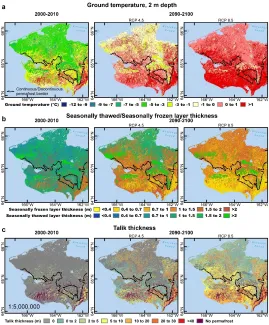NGEE Arctic researchers at the University of Alaska Fairbanks recently applied a transient temperature dynamic model to investigate the spatiotemporal evolution of permafrost conditions on the Seward Peninsula, Alaska—a region currently characterized by continuous permafrost in its northern part and discontinuous permafrost in the south. Led by Dmitry Nicolsky, these investigators calibrated model parameters using a data assimilation technique exploiting historical ground temperature measurements collected across the study area. The model was then evaluated with a separate control set of the ground temperature data. Calibrated model parameters were distributed across the domain according to ecosystem types. The forcing applied to their model consists of historic monthly temperature and precipitation data and climate projections based on the Representative Concentration Pathway (RCP) 4.5 and 8.5 scenarios. Simulated near‐surface permafrost extent for the 2000–2010 decade agrees well with existing permafrost maps and previous Alaska‐wide modeling studies. Future projections suggest a significant increase (3.0°C under RCP 4.5 and 4.4°C under RCP 8.5 at the 2 m depth) in mean decadal ground temperature on average for the peninsula for the 2090–2100 decade when compared to the period of 2000–2010. Widespread degradation of the near‐surface permafrost is projected to reduce its extent at the end of the 21st century to only 43% of the peninsula's area under RCP 4.5 and 8% under RCP 8.5.
For more information, please contact:
Matvey Debolskiy
mvdebolskiy@alaska.edu

